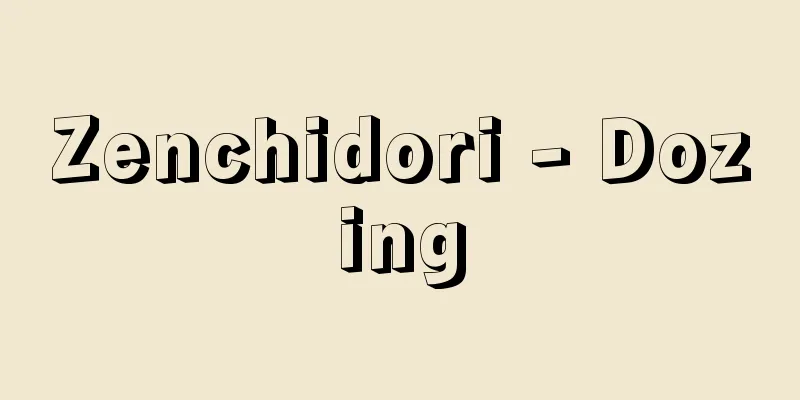Zenchidori - Dozing

|
Noh piece. Fourth piece. Five-school current piece. In the Kita school, it is written as "Uzu". It is an outstanding piece in terms of theme, lyrics, and direction, digging into the origins of the sins humans commit in order to survive, but the composer is unknown. A monk (waki) on a pilgrimage to Michinoku is entrusted with a message for his hometown by a dead man (mae shite) who used to be a hunter and has taken the appearance of an old man, at Tateyama in Ecchu Province (Toyama Prefecture), where Jigokudani is located. The monk meets the dead man's wife and children (tsure and kokata), and mourns the deceased. The second shite is the ghost of the hunter, who kills a parent bird by imitating the cries of the child, and as a punishment for catching the baby bird by the parent bird's voice, the dead man loses sight of his wife and child. He regrets having spent his days killing. But the excitement of hunting is revived. The realistic performance of swinging a stick to bring down the bird is unique to this Noh play. The bird then turns into a demon from hell and attacks, and despite prayers the deceased disappears into the dark world again. In contrast to the dull strength of the dark sea in "Akogi," which depicts a man killed for poaching, "Zenchidori" is characterized by its gruesome sharpness. The Auklet is the name of a bird that lives in the northern seas, and the desolate image of the northern sandy beaches is also an appropriate theme for this Noh play. Munakata Shiko also created a work based on this Noh play, "Zenchidori Woodblock Scroll." [Masuda Shozo] [Reference] |Source: Shogakukan Encyclopedia Nipponica About Encyclopedia Nipponica Information | Legend |
|
能の曲目。四番目物。五流現行曲。喜多流は「烏頭」と表記する。生きるために犯す人間の罪の原点をえぐって、テーマ、詞章、演出ともに傑出する能だが、作者は不明。陸奥(みちのく)へ行脚(あんぎゃ)する僧(ワキ)が、地獄谷のある越中(えっちゅう)国(富山県)の立山(たてやま)で、もと猟師であった老人姿の亡者(前シテ)から故郷への伝言を託される。亡者の妻子(ツレと子方)に会った僧は、死者を弔う。後シテは猟師の亡霊で、子の鳴き声をまねて親鳥を殺し、親鳥の声で子鳥をとった報いに、亡者の目には妻子の姿が見えなくなる。殺生に日を送った悔恨。だがまた猟の興奮がよみがえる。杖(つえ)を振るって鳥を落とす写実的な演技はこの能独自のものである。鳥はそのまま地獄の化鳥となって襲いかかり、祈りの力も及ばず、亡者はまた暗黒の世界に消えていく。密漁の罪で殺された男を描く『阿漕(あこぎ)』の暗い海の鈍い強さの表現に対し、『善知鳥』は悽惨(せいさん)な鋭さに特徴がある。ウトウは北の海にすむ鳥の名で、北辺の砂浜の荒涼たるイメージも、この能の主題にふさわしい。なお棟方志功(むなかたしこう)にこの能に材をとった『善知鳥板画巻』の作品がある。 [増田正造] [参照項目] |出典 小学館 日本大百科全書(ニッポニカ)日本大百科全書(ニッポニカ)について 情報 | 凡例 |
<<: Utougatani Cave - Utougatani Cave
>>: Auklet (Zenchidori) - Auklet
Recommend
Homo erectus (English spelling)
...In Europe, Pliopithecus , thought to be the an...
Penicillium citrinum (English spelling) Penicilliumcitrinum
…[Takeo Shinjiro]. … *Some of the terminology tha...
Hārūn al‐Rashid
766‐809 The fifth caliph of the Abbasid dynasty. R...
Fujiwara no Motohira - Fujiwara no Motohira
Year of death: 1157 Year of birth: Unknown. Milita...
Hot bee and Seran - Hot bee and Seran
…It is a fleshy perennial plant of the Agavaceae ...
Commissioner of the Righteous Army
Taking advantage of the internal conflicts among ...
Pipridae
...A general term for birds of the family Piprida...
Echinoderm - Echinoderm
A group of animals that make up a phylum, the hig...
Interest Calculation - Kinrikeisan
The ratio of the sum of dividends and capital gai...
réformé (English spelling) reforme
...The Catholic Guise Party began using this term...
Hijack - High jack
It is also called hijacking. It is the taking ove...
Murayama Touan
Year of death: 1619.12.1 (Genna 5.10.26) Year of b...
River Tweed
A river that flows through the Borders in southeas...
Omiwa no Takechimaro - Omiwa no Takechimaro
Year of death: Keiun 3.2.6 (706.3.24) Year of birt...
Mount Kitahodaka
...To the north from Okuhotakadake, you pass thro...



![Kusu [town] - Kusu](/upload/images/67cb68751e336.webp)
![Hatano [town] - Hatano](/upload/images/67cc863737020.webp)




